September 6, 1873, is a significant date in history for the Melbourne Cricket Club.
It is the foundation date of the Club’s heritage collections, with the donation of 13 bound volumes of the Australasian newspaper establishing a Library for Members’ enjoyment. Since then the collection has expanded with a presence in each of the Club’s four Members’ Pavilions.After decades of care under honorary librarians it was professionalised in the late 1980s and has grown into the modern reference library that today’s MCC Members know and love. The Club’s heritage collections have expanded to include the MCC Museum and MCC Archives alongside the MCC Library.
To celebrate 150 years of the collection, the MCC will be highlighting 150 treasured items from the collection over the next 12 months.
Items 9-20
Our Australian Game of Football

On his Reading Australian Football website, Tim Hogan of the State Library of Victoria describes this items as, “Promoted as a 'treatise on the Australian game of football', this book covers numerous aspects of football, with illustrated and instructional sections on the art, skills, psychology and tactics of the game, as well as fitness and training methods. An extensive chapter about 'systems and tactics' is of particular interest to students of the tactical evolution of the game. An article by VFL umpire Bob Scott provides an insight into the interpretation of the rules and the desired qualities for umpiring. Included are articles on ‘The Football Industry’, examining the manufacture of footballs, school football and football administration and several pictures and profiles of star players of the time from all states, including NSW and Queensland.”
[MCC Library Record #7659]
First published as McHale, J. F., Taylor, E. C. H. and Chadwick, A. E., The Australian Game of Football, (1931).
An instructional guide to Australian football produced in 1931, that provides practical information on the game. The authors include Collingwood Premiership coach and former player Jock McHale, Melbourne premiership player and captain, Bert Chadwick and Sports Master at Melbourne Church of England Grammar School, E. H. Taylor. A publication that is instructional and concerned that "Young Players" be able, "to avoid the acquirement of bad habits and faulty methods" and for "Senior Players" a hope that they, "recognize their failings and adopt the indicated remedy." Areas covered included uniforms, training, kicking, marking, handling the ball, tackling, turning, laws and tactics. Suggestions are provided on umpiring, coaching, school football, treatment of injuries and the psychology of football. Some player details and records are also included.
A copy is held in the Australian Gallery of Sport & Olympic Museum collection at the MCG Registration No.1988.1990
The 1936 edition is available online through the State Library of Victoria’s website.
QANFL Record

Another initiative of Andrew was to “professionalise” the QANFL’s program, the Record. It was first published in 1953 and early volumes had an educational emphasis. The “coronation souvenir” issued on June 2, 1953 (right) has team lists but no articles on players. Instead the markings of Australian football grounds, some basic rules and tips on playing the game are covered.
The program’s title changed regularly with the league’s name and sponsor. It has therefore been reinvented under names like the Queensland Australian Football League Foster's Football File, the QAFL Craven Filter Cup, the QAFL Escort Cup, the XXXX Premiership Footy Record and AFL Queensland Footy Record, to name a few.
In 2011 the North Eastern Australian Football League (NEAFL) was established through the QAFL’s amalgamation with AFL Canberra. This lasted until 2020, and the NEAFL league was amalgamated into the Victorian Football League from 2021.
[MCC Library Records # 15222]
James 'Diddley' Young's Certificate 1902
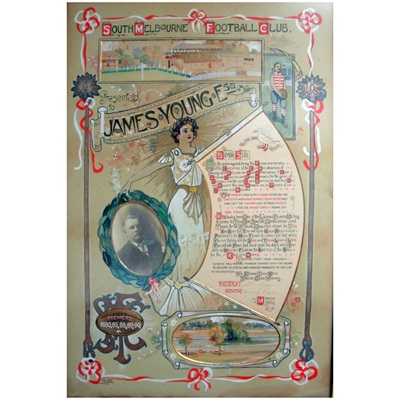
It was presented to Young by the South Melbourne Football Club in 1902. Among its illustrations are watercolour and gauche vignettes of South Melbourne’s bowls green and their Lake Oval grandstand. Young is also painted in his prime wearing a South Melbourne red and white hooped jerkin.
Young achieved much in his 18 years of top-flight football. He was a five-time premiership player with South (1881, 1885, 1888-90) and a respected clubman. He vice-captained South in 1883 and captained the club in 1884.
Ranked among the best players of his era, he played a total of eight games for Victoria, the equal most in the pre-VFL period. He played in Victoria’s first inter-colonial game on 1, 1879 against South Australia and also travelled to Adelaide the following year with the first Victorian touring team.
[MCC Library Record # 199136915]
The Victorian Football Guide for 1894
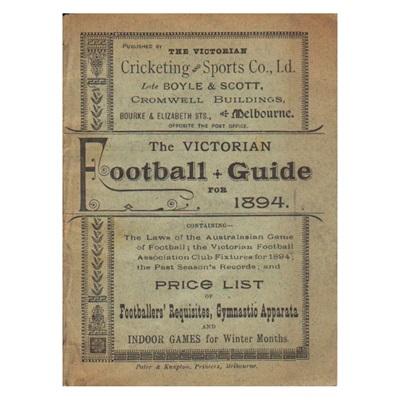
"containing - The Laws of the Australasian game of football; the Victorian Football Association Club Fixtures for 1894; the past season's records and price list of footballers' requisites, gymnastic apparata and indoor games for winter months."
Catalogue of equipment and clothing for Australian Football with the year's fixture & laws of the game, published by Victorian Cricketing & Sports Co. Ltd (Late Boyle & Scott), edited by J.K. Smith, Manager.
[MCC Library Record # 12346]
The Australian Game of... Football
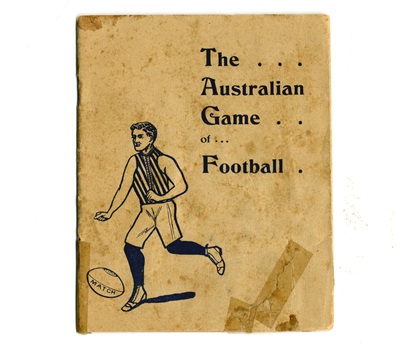
Issued by the Victorian Football League (now Australian Football League) in 1905, this brochure propagates two institutions – the game of Australian football and the sporting goods manufacturer T.W. Sherrin.
Throughout the 23-page booklet, discussions about the history of the sport and transcripts of its rules are interrupted by testimonials for the athletic equipment manufactured by T.W. Sherrin. This company followed a long tradition of sporting goods manufacturers and retailers funding propaganda materials for sporting bodies and clubs.
The booklet includes a history of the sport that was largely based on that from the Footballer of 1875, with an overemphasis on the role of HCA Harrison, who by the turn of the twentieth century had become regarded as the “Father of the Game”. The writer was bullish about the game’s progress over the three decades since 1875 too, with South Australia, Western Australia and Tasmania having “gone solid for the game”, while progress was also being made in New South Wales, Queensland, New Zealand and South Africa. In November 1905 a conference of football delegates from all Australian states and New Zealand met in Melbourne. This would lead to the formal establishment of the Australasian Football Council, the first national co-ordinating body for the sport, in November 1906.
The most recent testimonial concerning the “admirable shape and make, and also the quality of leather used” in the manufacture of Sherrin “Match II. Rugby Footballs” is dated May 10, 1905. Sherrin was one of a number of football manufacturers in turn of the century Melbourne. Thomas Sherrin’s first leather-goods factory was established in 1879, and through his role in local sports clubs, and the Collingwood Football Club in particular, its equipment came to prominence. His new design of football in the early 1900s was suited specifically for Australian football, and Sherrin balls soon spread throughout the continent. By mid-century the brand name was synonymous with the ball used for the Australian code.
[MCC Library Record # 60826]
See catalogue record here.
SA Footballer and SA Football Budget

From 1919 to 1926 it was published as the S.A. Footballer. During this era it released souvenir editions with colourised covers featuring leading footballers and even cartoon kewpie dolls in football attire.
The State Library of South Australia notes that, “The SA Footballer was first published in the 1919 season and continued until the end of the 1926 season. From 1927, the year the South Australian Football League (SAFL), changed its name to the South Australian National Football League (SANFL), it has been known as the South Australian Football Budget. Previously an SA Football Budget was published for the 1914 and 1915 seasons ending when the league competition went into recess for the rest of the First World War. All of these were official publications of the League.”
In 1927 the South Australian league took control of the program and renamed it the S.A. Football Budget. Colour souvenir editions would not reappear until the 1966 grand final and in 1967 the first large grand final Budget was published. Home-and-away match editions were A4-sized from 1982 but have been a slightly smaller B5 size since 2009.
Current digital issues are online here.
[MCC Library Records # 15536 & 4179]
WA Football Budget

In 1997 the publication changed its name to Real Footy, in 1998 to Football WA and later Westside Football before returning to the Football Budget in 2008. From 2008 it was given out free with each adult ticket to a WAFL game.
Issues for 2008-2023 are freely online here.
[MCC Library Record # 8337]
William Stanley Cock's Football (1885)

The Melbourne Cricket Club’s copy is the only known example. It is the first issue of the first volume and it is unknown if a second issue was released.
More details this unique treasure can be found at the article by Trevor Ruddell in issue 66 of The Yorker.
[MCC Library Record # 34835-01]
Football: Australian Rules (c.1934)
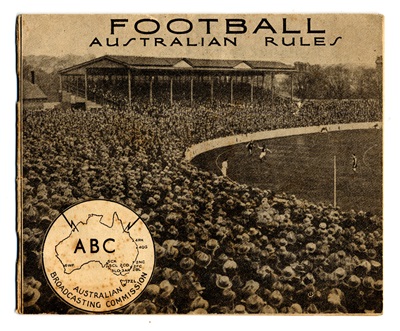
The ANFC secretary Con. M. Hickey introduced the booklet. Hickey had played for Fitzroy from 1887 to 1894 and in 1896, and having served as Fitzroy’s secretary from 1897 to 1910, was secretary of the ANFC from 1910 until his death in 1937.
The bulk of the 24-page book is a recitation of the sport’s rules (pages 3 to 20), with some tips on playing the game (pages 20-24) and a little over half a column on ANFC carnival statistics.
Of greater interest is the publisher, Australia’s national broadcaster, the ABC. The ABC has Australian football’s longest live broadcasting tradition. The first direct coverage of football on radio was the description by A.N. Bishop for 3AR (today the ABC’s Radio National) of the 1925 semi final at the MCG. For the grand final at the MCG the following week, former Geelong player Wallace “Jumbo” Sharland covered the Cats’ first grand final victory. An initial concern that radio would affect attendances was not realized. At the time this booklet was published in the mid-1930s, the ABC’s local radio station 3LO and its national station 3AR were the only weekly live broadcasters of league football in Melbourne.
See catalogue record here.
[MCC Library Record # 16370]
The Victorian Football Follower
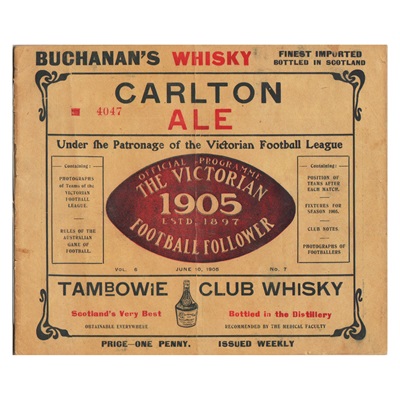
The Victorian Football Follower included team lists, player positions, premiership and goalkicking tables, reviews and previews of matches, photographs and gossip.
It was the forerunner of the Record but ceased publication before the universal introduction of player numbers.
[MCC Library Record # 8052]
Football Record

In 1912 Alfred Wood was a wholesale newspaper and publication distributor who obtained the sole right to publish player numbers from the league. As part of the agreement with the league, Wood was required to provide numbers to the clubs who would then allocate them to the players.
First released on April 27, 1912, the Record soon became a valued part of football culture and was referred to as the “little blue book” because of its pocket size and blue ink. It was highly sought by spectators because of its authority to print player numbers and request changes to them.
The early editions were not designed to be used only at matches. The first edition noted that many features were intended to “lead to the preservation of each number [issue], and consequently the little publication will go into the home – a recommendation of itself will appeal to Advertisers.”
Therefore, not just the player numbers and their positions on a diagram of the ground were included in early editions. Also featured were news and gossip, match reviews and previews, league fixtures, player photographs and profiles and premiership and goalkicking tables, all of which have been retained through the years.
The Football Record’s motto until 1941 was “fair play is bonnie play” and it guarded its exclusive right to publish numbers assiduously. Well into the 20th century it would ask players to use different numbers to thwart infringing publications. This occurred regularly in the 1910s and into the 1920s.Throughout the first half-century the cover illustration rarely distinguished a home-and-away match from a final, an interstate match from a night series game, or even a grand final from a reserve grade match.
For the 1953 lightning premiership, however, a souvenir colour edition was issued for the first time. The tournament was played at the MCG to celebrate Queen Elizabeth II’s coronation and a portrait of Her Majesty was featured on the cover.
When the Sun News-Pictorial published the names and numbers for the 1958 grand final sides on the morning of the match, perhaps the most famous of these guernsey alterations followed. The league forced all players except Collingwood’s Ray Gabelich to don different numbers. Prior to the 1959 final series the league received an undertaking from the newspaper’s publisher, Herald and Weekly Times Ltd, not to publish numbers.
In 1966 the first quarto-sized Record was issued for the grand final. This was continued in 1967 and in 1968 it was extended to all finals.
Though the Record’s exclusivity was challenged occasionally after the 1950s, it effectively ended in 1992 when the Herald-Sun published name and number lists in a weekly lift-out. By then the Record had outgrown its initial role as a player ready-reference. Although the AFL asked the paper to cease, according to that year’s AFL annual report sales of the Record “...hit an all-time high, reaching 1,494,720 for the home and away series and 198,106 for the finals”.
In 1999 the Football Record was rebranded the AFL Record. Recognising the Record’s significance, in 2011 the State Library of Victoria, in concert with the AFL and Slattery Media, digitised and uploaded thousands of historical issues dating from 1912 as part of the Victorian Historical Publications Digitisation Project.
You can find them here.
The Football Record may have begun as a player ready-reference accompanied by images and articles, but it’s much more than that today. However modern its design and availability, it has the wonderfully quaint cachet of familiarity cherished by generations of barrackers. From hearing the call “Record!” by its vendors, to penciling goals next to players’ names, to flipping through your mangled copy while going home on the train, the Record has become more than a magazine, more than a souvenir. It’s an intrinsic element of Australian football’s culture and the rituals associated with it.
More details can be found at the article on the Centenary of the Football Record by Trevor Ruddell in issue 47 of The Yorker from 2012.
[MCC Library Record # 862]
Rugby League News

Rugby League News was the equivalent of the Football Record, covering all range of news and information for the NSWRL including player profiles, historical articles, interstate and international competition as well as the Sydney premiership. [There was a similar publication in Brisbane for the QRL, which we will highlight another time.]
When the first issue was published in May 1920, Smith's Weekly, Sat 8 May 1920, noted on page 7,
“ITS OWN PAPER
'The Rugby League News,' published by the League, made its appearance at the Saturday's matches. It was appreciated, so the League's coffers should benefit. Provision might be made in it for the recording of match results by patrons who desire to preserve it as a record of the season.”
The MCC Library’s holdings are mainly from the Pat Mullins collection, and there is an emphasis on interstate and international matches, specifically against New Zealand, France and Great Britain. It was replaced by 'Big League Magazine' in 1974.
The NSW State Library has digitised the complete run from 1920-1973. They can be found here.
[MCC Library Record # 7374]

.jpg)